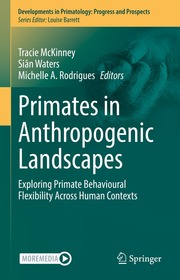
Primates in Anthropogenic Landscapes
Exploring Primate Behavioural Flexibility Across Human Contexts
Series: Developments in Primatology: Progress and Prospects;
- Publisher's listprice EUR 58.84
-
24 403 Ft (23 241 Ft + 5% VAT)
The price is estimated because at the time of ordering we do not know what conversion rates will apply to HUF / product currency when the book arrives. In case HUF is weaker, the price increases slightly, in case HUF is stronger, the price goes lower slightly.
- Discount 12% (cc. 2 928 Ft off)
- Discounted price 21 475 Ft (20 452 Ft + 5% VAT)
Subcribe now and take benefit of a favourable price.
Subscribe
24 403 Ft

Availability
printed on demand
Why don't you give exact delivery time?
Delivery time is estimated on our previous experiences. We give estimations only, because we order from outside Hungary, and the delivery time mainly depends on how quickly the publisher supplies the book. Faster or slower deliveries both happen, but we do our best to supply as quickly as possible.
Product details:
- Edition number 1st ed. 2023
- Publisher Springer International Publishing
- Date of Publication 2 January 2023
- Number of Volumes 1 pieces, Book
- ISBN 9783031117350
- Binding Hardback
- No. of pages346 pages
- Size 235x155 mm
- Weight 711 g
- Language English
- Illustrations XIII, 346 p. 36 illus., 29 illus. in color. Illustrations, black & white 425
Categories
Long description:
The field of primatology has expanded substantially in the last twenty years, particularly with regard to studies of primates in human-altered landscapes. This text aims to review the recent literature on anthropogenic (of human origin) influences on non-human primates, bringing an overview of this important area of primatology together for students. Chapters are grouped into three sections, representing the many ways anthropogenic activities affect primate populations. The first section, ‘Human Influences on Primate Habitat’, covers ways in which wild primates are affected by human actions, including forest fragmentation, climate change, and the presence of dogs. Section two, ‘Primates in Human-Dominated Landscapes’, looks at situations where non-human primates and humans share space; this includes primates in urban environments, primate tourism, and primates in agroecosystems. The final section, ‘Primates in Captivity’, looks at primate behaviour and welfare in captive situations, including zoos, the primate pet trade, and in entertainment.
Table of Contents:
Introduction.- Part 1-Human Influences on Primate Habitats.- Forest Fragmentation.- Primates in Regenerating Forest.- Responses of primates to roads: Dispersal barriers, mortality, and secondary effects.- Hunting by humans.- Primate-dog interactions.- Primate Tourism.- Infectious disease.- Climate change impacts on non-human primates – what have we modelled and what do we do now?.- PART 2: PRIMATES IN HUMAN-DOMINATED LANSCAPES.- Community-based conservation strategies to promote primate conservation in agricultural landscapes.- Translocated primate populations.- Translocated primate populations.- Exploring the human-primate interface.- Planning primate conservation in shared landscapes.- Non-pathogenic influences on primate health and behaviour.- PART 3: PRIMATES IN CAPTIVITY.- Anthropogenic and observer effects on primate behaviour: Perspectives on the continuum of wild-captive behaviour.- The primate pet trade.- Rescue, rehabilitation, and reintroduction.
More



